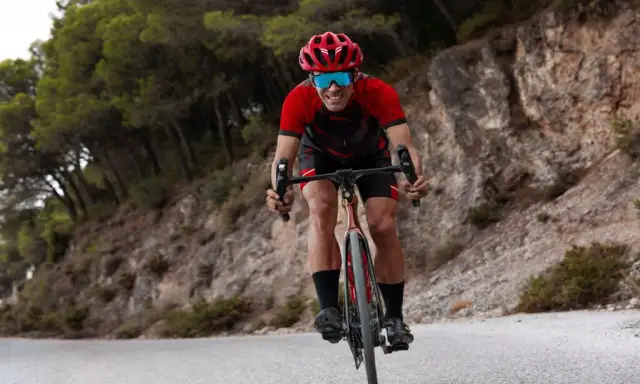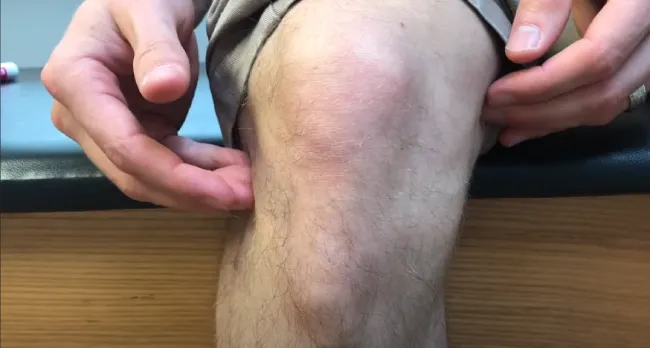Knee cartilage damage can cause pain, inflammation, clicking noise and catching sensation, and reduced joint range of motion. More exhaustive cartilage injuries can cause osteoarthritis, a degenerative common condition.
The knee does not undergo significant impacts in cycling. However, the continuous concentric movement (sustained pedaling motion with intensity changes) produces microtrauma. Pedaling biomechanics is complex since the constant fixation point of the forefoot conditions the knee’s natural movement.
This post will investigate the connection between cycling and knee cartilage damage. We’ll discuss the potential risks tied to cycling. We’ll also highlight identifying symptoms of knee cartilage damage, preventive strategies, and safe practices to ensure your love for cycling is healthy.
Does Cycling Damage Knee Cartilage: 8 Risks and Causes

Cycling can pose some risks if done improperly or excessively. Our goal will be to discuss the dangers of cycling for knee cartilage health in greater detail. Here are some common factors contributing to knee problems when cycling:
Pedaling with too high or too low cadence
- A too-high cadence (usually over 110 RPM): can cause the knee joint to experience more stress than it should. It can also lead to inefficient cycling and increased load on the knee joint.
- A too-low cadence (usually under 60 RPM): can increase the potential of causing knee pain because it can put more pressure on the knee joint.
Using too-high or too-low gears
- Using gears that are too high can put more strain on your knee joint, which can lead to damage over time.
- Using gears that are too low can lead to overuse injuries because they require more revolutions per minute.
Having an incorrect saddle height or position
- A too-high or too-low saddle can cause hyperextension or flexion, respectively, of the knee, increasing the pressure and friction on the cartilage.
- A too-forward or backward saddle can cause anterior or posterior tilt, respectively, of the pelvis, which affects the knee’s stability.
Having an incorrect cleat alignment or position
- Improper cleat alignment can cause stress and shear on the knee cartilage and affect the rotation and movement of the foot and ankle.
- Incorrect cleat position can also affect the power and efficiency of the pedaling.
Torn Cartilage in the Knee
- Cycling is a great way to stay fit, but it comes with risks. If not done correctly, the repetitive pedaling motion damages knee cartilage.
- This may be because of improper saddle and cleat positioning or overexertion without adequate rest periods. Taking precautions to prevent injury and enjoy the benefits of cycling is crucial.
Cartilage Loss in the Knee
- Long-term cycling can be incredibly intense and may lead to cartilage loss in the knee. Despite being a low-affected exercise, cycling involves a lot of knee movement.
- If this movement is not balanced with adequate rest and recovery, it could cause gradual wear and tear, eventually leading to cartilage loss.
Broken Cartilage in the Knee
- Breaking the knee cartilage while cycling is rare but dangerous. It usually happens when the knee is suddenly affected by an accident or a fall from the bike.
- Cyclists should take extra precautions to avoid such accidents and wear protective gear like knee pads.
Direct Blow to the Knee
- One risk factor for knee cartilage damage while cycling is direct impact or blow to the knee. This could happen if you fall off your bike or collide with something during your ride.
- When the knee takes a brutal hit, the cartilage can be injured, causing pain and swelling. This type of injury may need medical attention and could require rest and recovery before you can return to your bike.
Wear and Tear Over Time
- The second risk is wear and tear. Cycling involves a lot of repetitive motion. Each time you pedal, your knee bends and straightens, stressing the cartilage.
- Over time, this constant movement can cause the cartilage to wear down. This is especially true if you often cycle or do high-intensity cycling workouts.
4 Symptoms of Damaged Knee Cartilage Caused By Cycling
Cycling is a popular, low-affected exercise with many health benefits. However, like any physical activity, it comes with potential risks. One risk that has raised concerns among cyclists is the potential for cycling to damage the knee cartilage. Understanding the symptoms of damaged knee cartilage can help you identify problems early and seek treatment.
Pain and Tenderness
One of the most common symptoms of damaged knee cartilage is pain. This may be a sharp, shooting pain during activity or a dull ache that lingers even at rest.
The pain may worsen when you bend or straighten your knee, especially when cycling or descending stairs. Tenderness often accompanies this pain. You may find your knee hurts when you touch it or apply pressure.
Locking of the Knee
Another symptom that may suggest cartilage damage is the locking of the knee. This occurs when a piece of damaged cartilage loosens and becomes trapped between the bones in the knee joint, preventing it from sliding.
You can lock up or freeze in one position, making bending or straightening your knee difficult. If you experience this symptom, seeking medical attention promptly is crucial, as it can signal a severe injury.
Swelling and Inflammation
Swelling is a typical response to injury. If your knee cartilage is damaged, you may notice that your knee appears larger or puffier than usual. This swelling can occur immediately after an injury or evolves. Inflammation often accompanies swelling.
It is the body’s natural response to injury and is characterized by redness, warmth, and sometimes a feeling of heat in the knee area.
Limited Range Of Motion And Stiffness
Stiffness is another symptom showing damaged knee cartilage. Your knee may feel stiff, especially after periods of inactivity, such as when you wake up or sit for a long time. This stiffness can make it hard to move your knee normally.
Diagnosis of Knee Cartilage Damage Caused By Cycling
Diagnosing this condition accurately is crucial for effective treatment and recovery. Still, it can be more complex because of the symptoms similar to other knee injuries. Here are some processes medical professionals use to diagnose knee cartilage damage.
Physical Examination
The first step in diagnosing knee cartilage damage is usually a physical examination. It’s important to tell the doctor about your symptoms and medical history, including any specific incidents that might have led to the injury, like a fall during cycling. This is followed by a thorough examination of your knee, where the doctor will check for signs of damage, such as swelling, tenderness, or limited range of motion.
Diagnostic Tests
If the doctor suspects cartilage damage based on the physical examination, they may order further diagnostic tests to confirm their suspicions. Besides detecting damage, these tests can also determine how bad it is.
Magnetic Resonance Imaging (MRI)
An MRI is a non-invasive imaging method that generates detailed images of the body’s internal structures using radio waves and magnetic fields. It’s beneficial for visualizing soft tissues, including cartilage. However, while MRIs are valuable tools, they have limitations. Sometimes, they may not detect minor cartilage damage.
Arthroscopy
An arthroscopy allows doctors to examine and repair joints. During an arthroscopy, a small, tube-like instrument called an arthroscope is passed through the knee. The arthroscope has a camera that sends images to a monitor so the doctor can see the joint and assess the cartilage damage.
Cycling Damages Knee Cartilage: Preventive & Treatment
There are effective preventive and treatment measures that you can take to protect your knees and enjoy cycling without pain or damage.
3 Preventive Measures

A. Mitigating the risks of cartilage damage through proper bike fit, adapted cycling form, and regular stretching
Proper Bike Fit:
Ensuring your bike fits you well is essential to prevent knee cartilage damage from cycling. A proper bike fit can reduce the stress and strain on your knees and improve your pedaling efficiency, comfort, and performance. Some essential factors that you need to consider while selecting the proper bike fit are:
- Optimal saddle height, fore-aft position, and angle.
- Correct handlebar height, reach, and width.
Cycling Form:
A good cycling form can reduce the unnecessary movements and forces on your knees, which can help you avoid knee cartilage damage. Follow these tips to adopt a good cycling form:
- Keep your knees in line with your feet and hips, and avoid excessive inward or outward rotation of your knees.
- Pedal smoothly and evenly, and avoid jerky or erratic motions.
- Use a suitable cadence (the number of revolutions per minute of your pedals) and gear ratio, and avoid grinding or spinning too fast or too slow.
- Distribute your weight evenly on the saddle, pedals, and handlebars, and avoid leaning too much on one side or the other.
- Relax your upper body and arms, and avoid gripping the handlebars too tightly or tensely.
Regular Stretching
Regular stretching can also help protect knee cartilage by improving flexibility, mobility, and blood circulation. Stretching can also reduce the stiffness, soreness, and inflammation in your muscles, tendons, and joints. Some of the best stretches that you can perform to prevent knee cartilage damage are:
- Quadriceps stretch.
- Hamstring stretch.
- Calf stretch.
- Glute stretch.
- IT band stretch.
5 Non-Surgical Knee Cartilage Treatment Methods
For medical treatments, several non-surgical options are available for treating knee cartilage damage. Here are a few of them:
RICE Regimen
One of the first lines of treatment for knee cartilage injury is the RICE regimen, rest, Ice, Compression, and Elevation. Resting your knee helps reduce further damage. Applying ice can help minimize swelling and pain. Compression, often using an elastic bandage, can provide support and reduce swelling, and elevating your knee can help decrease inflammation.
Medications and Injections
An over-the-counter pain reliever and anti-inflammatory medication can also help manage symptoms. Sometimes, your doctor may recommend corticosteroids, anti-inflammatory medications, or platelet-rich plasma (PRP) injections to reduce inflammation and promote healing.
Appropriate Nutrition
Appropriate nutrition is vital for knee cartilage healing. A balanced diet with enough protein, carbohydrates, fats, vitamins, minerals, and water can help your body repair the damaged tissues and restore your knee function. Some of the best foods to aid knee cartilage healing are:
- Lean meats, fish, eggs, dairy products, soy, beans, and nuts.
- Fruits, vegetables, whole grains, and legumes.
- Olive oil, avocado, nuts, seeds, and fatty fish.
- Citrus fruits, berries, broccoli, spinach, peppers, and tomatoes.
Physiotherapy

Physiotherapy can help you rehabilitate your knee cartilage after an injury or damage. A trained physiotherapist can help you with exercises that can strengthen the muscles around your knees, which can lessen pain and stiffness.
Castor Oil for Knee Cartilage Health
To use castor oil for knee pain, simply warm it slightly and apply it to the affected area. Then, cover it with a cloth and top it with a hot water bottle. Oil penetrates deeper into the skin, potentially relieving pain and inflammation. Remember, while castor oil may help ease symptoms, it’s not a cure for cartilage damage and should be used as a complementary treatment.
Other Strategies and Tactics:
Different strategies and tactics to minimize knee cartilage damage during cycling
- Use Knee Pads: Knee pads can reduce the impact on your knees and protect you from accidental falls or crashes.
- Use Clip-in Pedals: Clip-in pedals can help you maintain a better cycling form and reduce knee stress and movements.
- Increase Mileage Gradually: Accumulate your cycling mileage gradually instead of abruptly. Sudden changes in mileage or intensity can damage knee cartilage.
5 Surgical Treatments For Knee Cartilage Damage
Cycling keeps you active and healthy. However, it brings its risks, including potential damage to knee cartilage. If you’re dealing with this condition, understanding the treatment options and the associated recovery time will be crucial for your healing journey. Let’s explore some treatments for cartilage damage and the associated recovery times.
Knee Cartilage Replacement
Also known as autologous chondrocyte implantation (ACI), knee cartilage replacement is a procedure where a patient’s cells are grown and implanted into the damaged knee area. Patients typically undergo the procedure for a single area of cartilage damage.
Knee Injections for Cartilage Regeneration
Hyaluronic acid injections (HA) and platelet-rich plasma (PRP) are sometimes used to stimulate cartilage regeneration and ease symptoms of cartilage damage. While these treatments can provide symptomatic relief, they don’t cure the underlying cartilage damage.
Synthetic Knee Cartilage Replacement
This procedure involves implanting synthetic materials, such as polymers, into the knee to replace damaged cartilage. While this is a less common treatment option, it might be considered for patients who aren’t candidates for other procedures.
Cartilage Transplant
In a cartilage transplant, healthy cartilage tissue is taken from a non-weight-bearing knee area or a donor and . The procedure is for younger people with smaller areas of cartilage damage.
Bone Marrow Stimulation
Bone marrow stimulation techniques, such as microfracture surgery, involve creating small gaps beneath damaged cartilage to promote the growth of new cartilage. This is a less invasive option and is often used for smaller areas of damage.
Conclusion
Depending on various factors, cycling can be beneficial or detrimental to knee cartilage health. In some cyclists,the low-impact nature of cycling and its positive effect on joint mobility and inflammation may result in cartilage damage or pain.
The critical takeaway is approaching cycling with caution, respect, and proper knowledge of preventing knee cartilage damage. This blog post has provided the information and insights to keep your knees healthy and pain-free during cycling. Remember to prioritize safety, listen to your body, and consult your doctor if you experience warning signs of cartilage damage.
FAQs
Is Walking Or Biking Better For Knees?
Cycling can be better for people with joint pain because your weight is supported on the bike seat, so the impact and stress on your knees can be even lower than walking. A proper bike fitting and technique will prevent knee strain.
How To Regenerate Knee Cartilage Naturally?
Low-impact exercise is excellent for your joints. By strengthening the muscles surrounding the joints, low-affected exercises can prevent injuries and relieve joint pressure. Ensure that you follow a diet that promotes cartilage.
How Does Cycling Affect Knee Cartilage?
The pedaling action eases movement while strengthening and extending the knee joint. The results of one study indicated that more extended-duration exercises, such as cycling and running, increased cartilage thickness after 5 minutes of exercising.





